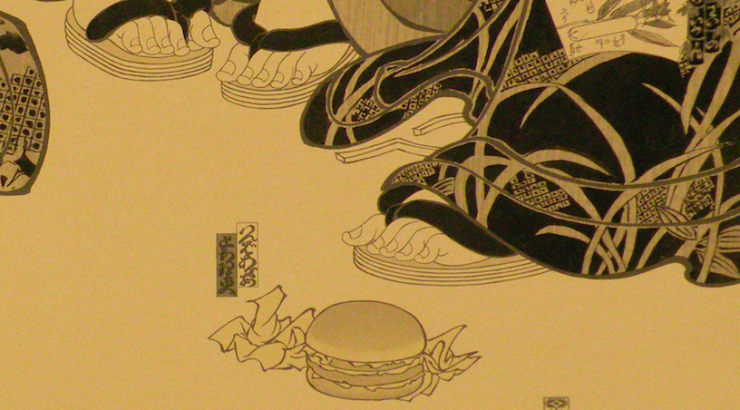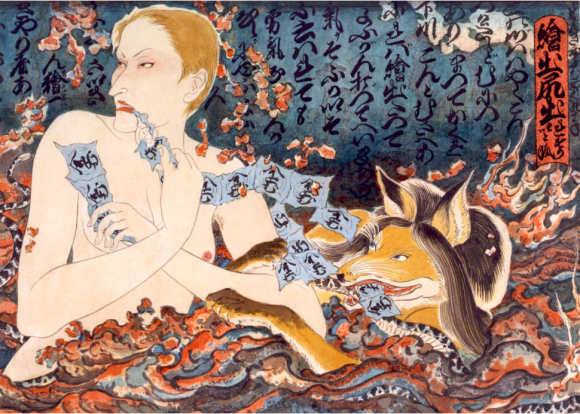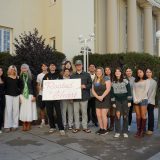
Masami Teraoka Contemporary Issues Through a Ukiyo-e Lens
March 16, 2017
Masami Teraoka is a Japanese-American artist who was born in Onomichi, the Hiroshima Prefecture of Japan in 1936. His artwork blends traditional Japanese Edo aesthetic with American culture and contemporary issues. Teraoka received a B.A. in Aesthetics at Kwansei Gakuin University in Kobe, Japan, before moving to Los Angeles in 1961, where he received his Bachelor of Fine Arts and Master of Fine Arts at the Otis College of Art and Design. Over his lifetime, Masami Teraoka has had over 70 solo exhibitions, and has his work in over 50 public collections and museums around the world. He is currently 80 years old, and lives in Hawaii with his wife, artist Lynda Hess, and their daughter, Eve.
Earlier works painted by Teraoka showcase his critique of American culture by using impossible combinations of 17th century Ukiyo-e Japanese figures and contemporary American icons. The Ukiyo-e style largely focuses on the fleeting beauty of nature, women, and transitory pleasures. Teraoka uses McDonalds hamburgers, golf clubs, and ice cream cones to poke fun at American indulgence and seemingly trivial leisure activities, as well as to draw comparisons between these and the “floating world” depicted in ukiyo-e prints. Two of these earlier screenprints, French Vanilla, and Chocolate Chip, from Teraoka’s 31 Flavors Invading Japan series are located in Beckman Hall, as a part of the Escalette Permanent Collection of Art. These pieces show Terakoa’s humorous approach to contemporary topics, and his interest in the homogenization of western and eastern cultures as Western pop-culture spread across Japan in the 1970s.

Masami Teraoka, AIDS Series: Woman and Fox, 1991, Watercolor on paper. Source: http://masamiteraoka.com/archive/early_work.html
Teraoka was inspired to create another painting series in 1989 during a visit to the Victorian College of the Arts in Melbourne, Australia. While there, he realized that the Australian people had little to no grasp of the reality of AIDS as an increasingly widespread disease; not even doctors or nurses seemed to believe that AIDS was a realistic threat to the Australian people. This became especially apparent to Teraoka after he was shown the hats and shoe covers that were the only precaution the doctors took to prevent the spreading of AIDS. In reaction to the ignorance he observed in Australia, Teraoka started creating a series of watercolor paintings that mimicked traditional Japanese woodblock prints. Ghostly figures, depicted with blue hues sweeping across their eyes like a mask, are shown quickly working to tear open condoms, surrounded by foxes. The condoms, according to Teraoka, represent the ability to contract AIDS even when used properly. The cherry blossom petals seen throughout the work signify past memories, and the foxes represent kitsune (divine foxes that serve as messengers in Japanese folklore) who are trying to warn the figures of the risks of AIDS.

Masami Teraoka, Adam and Eve / Mousetrap, 1995, Watercolor on paper. Source: http://masamiteraoka.com/archive/recent_work.html
Teraoka’s recent areas of interest have been inspired by works from the Italian and Northern Renaissance. His Adam and Eve Series takes place in a world modeled after Hieronymus Bosch, a 15th century Dutch painter whose lustful, futuristic paintings still attract much controversy today. Teraoka’s modern Adam and Eve is depicted completely overcome by technology. Computer mouses tangle around their bodies, trapping them while vultures pick at their bodies. In another work in this series, a surge protector is placed off to the side, wrecking havoc on Adam, and Eve, who holds a keyboard above her head for protection. Teraoka uses traditional oil paints in order to create these Renaissance-inspired pieces. This demonstrates Teraoka’s ability to adapt his painting style to match his subject matter, while maintaining his use of the traditional Ukiyo-e figures. His merging of Ukiyo-e style, Renaissance subject matter, and modern circumstances illustrates the relevance of similar social issues across cultures.
Stop by Beckman Hall to take a look at Masami Teraoka’s provocative and contemplative works!
All text and images under copyright. Please contact collections@chapman.edu for permission to use. Information subject to change upon further research.


